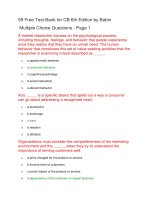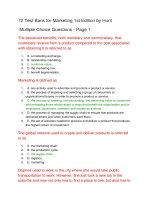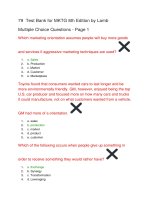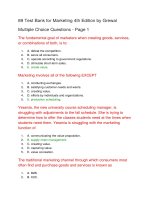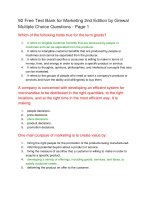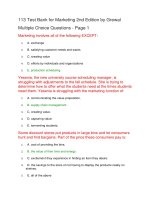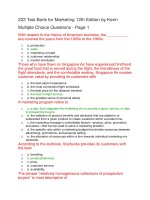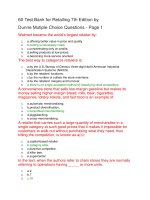Test bank for MM 2nd edition by iacobucci
Bạn đang xem bản rút gọn của tài liệu. Xem và tải ngay bản đầy đủ của tài liệu tại đây (67.61 KB, 6 trang )
Full file at />
Chapter 1: What Is Marketing?
TRUE/FALSE
1. Marketing is defined as an exchange between a firm and its customers.
ANS: T
PTS: 1
REF: Page 2
MSC: AACSB Reflective Thinking | TB&E Model Strategy | Knowledge of General Business
Functions
2. Customers typically do not mind paying for purchases.
ANS: T
PTS: 1
REF: Page 3
MSC: AACSB Analytic | TB&E Model Customer | Knowledge of General Business Functions
3. Marketers try to figure out what customers want and then they try to figure out how to provide it and
make money doing so.
ANS: T
PTS: 1
REF: Page 3
MSC: AACSB Analytic | TB&E Model Customer | Managing Strategy & Innovation
4. In an exchange, the customer wants something from the company but the company wants nothing from
the customer.
ANS: F
PTS: 1
REF: Page 3
MSC: AACSB Analytic | TB&E Model Customer | Knowledge of Human Behavior & Society
5. Companies like taking in profits more than they care about their customers.
ANS: F
PTS: 1
REF: Page 3
MSC: AACSB Reflective Thinking | TB&E Model Customer | Managing Human Capital
6. The term “market” sounds like it involves selling simple, tangible goods, but as you know, hardly
anything can be marketed.
ANS: F
PTS: 1
REF: Page 4
MSC: AACSB Reflective Thinking | TB&E Model Marketing Plan | Managing Strategy & Innovation
7. Marketers help athletes, celebrities, and politicians with their images in their respective marketplaces
(to fans and agents, intelligentsia, or the public).
ANS: T
PTS: 1
REF: Pages 4-5
MSC: AACSB Communication | TB&E Model Promotion | Knowledge of Media Communications &
Delivery
8. Some things that can be marketed include goods, services, experiences, events, and people.
ANS: T
PTS: 1
REF: Page 4
MSC: AACSB Communication | TB&E Model Promotion | Knowledge of Media Communications &
Delivery
9. These days we live in a truly product-oriented and product-empowered marketing world.
ANS: F
PTS: 1
REF: Page 5
MSC: AACSB Analytic | TB&E Model Product | Knowledge of Technology, Design, & Production
10. Many management gurus believe that marketing has succeeded so well that it really isn’t a function in
an organization anymore.
ANS: T
PTS: 1
REF: Page 6
MSC: AACSB Reflective Thinking | TB&E Model Marketing Plan | Knowledge of General Business
Functions
11. Diana is the marketing vice president at Company ABC. As she assesses any particular business
problem or opportunity in terms of general analysis, she should review the 5Ps.
ANS: F
PTS: 1
REF: Page 6
MSC: AACSB Reflective Thinking | TB&E Model Marketing Plan | Knowledge of General Business
Functions
12. One of the factors currently stressing marketers is the pressure to show results.
ANS: T
PTS: 1
REF: Page 6
buy this full document at
13.
14.
15.
16.
17.
18.
19.
20.
21.
22.
Full file at />MSC: AACSB Analytic | TB&E Model Research | Operations Skills
Marketing management is the overseeing of the processes of the 5C, STP, and 4P components.
ANS: T
PTS: 1
REF: Page 6
MSC: AACSB Reflective Thinking | TB&E Model Marketing Plan | Managing Administration &
Control
You’ll always be a step ahead of your competition if you simply think about your company.
ANS: F
PTS: 1
REF: Page 7
MSC: AACSB Reflective Thinking | TB&E Model Strategy | Strategic & System Skills
The 5Cs, STP, and 4Ps operate interdependently.
ANS: T
PTS: 1
REF: Page 8
MSC: AACSB Analytic | TB&E Model Marketing Plan | Managing Strategy & Innovation
Every purchase begins with an assessment of convenience or wants.
ANS: F
PTS: 1
REF: Page 8
MSC: AACSB Analytic | TB&E Model Strategy | Managing Decision-Making Processes
Buyers look for possible products and try to find information to guide them as to which might be the
best brand for their unique situation.
ANS: T
PTS: 1
REF: Page 8
MSC: AACSB Reflective Thinking | TB&E Model Customer | Knowledge of Human Behavior &
Society
The buying process varies depending on whether the buyer is a consumer or a business.
ANS: F
PTS: 1
REF: Page 9
MSC: AACSB Analytic | TB&E Model Marketing Plan | Managing Decision-Making Processes
B2B marketers have identified four kinds of purchases.
ANS: F
PTS: 1
REF: Page 9
MSC: AACSB Reflective Thinking | TB&E Model Pricing | Managing Decision-Making Processes
Cultural and social factors heavily influence differences in customer preferences.
ANS: T
PTS: 1
REF: Page 11
MSC: AACSB Diversity | TB&E Model Customer | Knowledge of Human Behavior & Society
Great marketing is based on sound, logical—emotional and physical—laws of human and organization
behavior.
ANS: F
PTS: 1
REF: Page 12
MSC: AACSB Reflective Thinking | TB&E Model Customer | Knowledge of Human Behavior &
Society
Country, culture, and subculture influence consumer purchases but NOT organizational purchase
decisions.
ANS: F
PTS: 1
REF: Page 11
MSC: AACSB Reflective Thinking | TB&E Model Customer | Knowledge of Human Behavior &
Society
MULTIPLE CHOICE
1. Marketers try to figure out what _____ want and then they try to figure out how to provide it and
make money doing so.
a. business owners
c. advertisers
b. customers
d. companies
ANS: B
PTS: 1
REF: Page 3
MSC: AACSB Analytic | TB&E Model Customer | Managing Strategy & Innovation
2. Which of the following is defined to be an exchange between a firm and its customers?
a. advertising
c. marketing
b. consumer behavior
d. none of the above
buy this full document at
Full file at />ANS: C
PTS: 1
REF: Page 3
MSC: AACSB Reflective Thinking | TB&E Model Strategy | Operations Skills
3. If companies are good and if they’re lucky, the exchange continues iterating between the customer
and the company, _____ the tie between them.
a. strengthening
c. distracting
b. weakening
d. exhausting
ANS: A
PTS: 1
REF: Page 3
MSC: AACSB Reflective Thinking | TB&E Model Strategy | Operations Skills
4. Marketers help/work with all of the following EXCEPT
a. athletes.
c. department stores.
b. hotels.
d. All can be helped by marketers.
ANS: D
PTS: 1
REF: Pages 4-5
MSC: AACSB Communication | TB&E Model Promotion | Knowledge of Media Communications &
Delivery
5. On what did the early marketplace primarily focus?
a. product
c. price
b. promotion
d. place
ANS: A
PTS: 1
REF: Page 5
MSC: AACSB Reflective Thinking | TB&E Model Product | Managing Strategy & Innovation
6. Today’s marketplace is focused more on
a. business.
c. product.
b. customers.
d. price.
ANS: B
PTS: 1
REF: Page 5
MSC: AACSB Communication | TB&E Model Customer | Knowledge of Human Behavior & Society
7. Marketing is thought to be evidence of an evolved
a. society.
c. customer.
b. business.
d. market.
ANS: D
PTS: 1
REF: Pages 5-6
MSC: AACSB Analytic | TB&E Model Strategy | Knowledge of General Business Functions
8. What is the result companies see from happier customers due to marketing?
a. Companies are less profitable
c. Companies are more profitable
b. Companies market less
d. Nothing
ANS: C
PTS: 1
REF: Page 6
MSC: AACSB Analytic | TB&E Model Marketing Plan | Managing Decision-Making Processes
9. The letters CMO represent
a. Chief Management Officer.
c. Central Management Officer.
b. Central Marketing Organization.
d. Chief Marketing Officer.
ANS: D
PTS: 1
REF: Page 6
MSC: AACSB Reflective Thinking | TB&E Model Marketing Plan | Knowledge of General Business
Functions
10. Advertising's goal is to enhance
a. brand image.
c. marketing.
b. profit.
d. purchases.
ANS: A
PTS: 1
REF: Page 6
MSC: AACSB Communication | TB&E Model Promotion | Managing Strategy & Innovation
buy this full document at
Full file at />11. Which of the following is NOT part of the 5Cs?
a. context
c. corporation
b. customer
d. competitors
ANS: C
PTS: 1
REF: Page 7
MSC: AACSB Analytic | TB&E Model Marketing Plan | Knowledge of General Business Functions
12. A company’s marketing executives should assess the _____ in terms of a general analysis of a
business problem or opportunity the company is facing.
a. business situation
c. STP
b. 5Cs
d. ARA
ANS: B
PTS: 1
REF: Page 7
MSC: AACSB Analytic | TB&E Model Marketing Plan | Knowledge of General Business Functions
13. Which of the following is NOT a part of STP?
a. segmentation
c. targeting
b. positioning
d. All are part of STP
ANS: D
PTS: 1
REF: Page 7
MSC: AACSB Analytic | TB&E Model Marketing Plan | Knowledge of General Business Functions
14. The 4Ps include all of the following EXCEPT
a. positioning.
c. product.
b. price.
d. place.
ANS: A
PTS: 1
REF: Page 7
MSC: AACSB Analytic | TB&E Model Marketing Plan | Knowledge of General Business Functions
15. Fundamentally, the best marketers put themselves in the place of their
a. company.
c. competitors.
b. customers.
d. friends.
ANS: B
PTS: 1
REF: Page 7
MSC: AACSB Reflective Thinking | TB&E Model Customer | Managing Strategy & Innovation
16. What order is correct for a situation analysis?
a. 5Cs, 4Ps, STP
c. 5Cs, STP, 4Ps
b. 4Ps, 5Cs, STP
d. STP, 5Cs, 4Ps
ANS: C
PTS: 1
REF: Page 7
MSC: AACSB Analytic | TB&E Model Marketing Plan | Knowledge of General Business Functions
17. What kind of customer is an agent buying something on behalf of an organization?
a. business
c. administrative
b. Internet
d. None of the above
ANS: A
PTS: 1
REF: Page 9
MSC: AACSB Communication | TB&E Model Strategy | Managing the Task Environment
18. Which approach assumes that a customer would compare all the possible brands along the attribute
or dimension that is most important to them?
a. helicograph
c. mesmograph
b. lexicographic
d. None of the above
ANS: B
PTS: 1
REF: Page 10
MSC: AACSB Reflective Thinking | TB&E Model Product | Strategic & System Skills
19. B2B marketers have said there are three kinds of purchases - new buy, modified rebuy, and
a. alternate rebuy.
c. convenience rebuy.
b. old buy.
d. straight rebuy.
buy this full document at
Full file at />ANS: D
PTS: 1
REF: Page 9
MSC: AACSB Reflective Thinking | TB&E Model Customer | Knowledge of General Business
Functions
20. Which of the following is NOT involved in a B2B purchase?
a. Initiator
c. Administrator
b. Influencer
d. Gatekeeper
ANS: C
PTS: 1
REF: Page 10
MSC: AACSB Analytic | TB&E Model Marketing Plan | Knowledge of General Business Functions
21. Brian is a recent college graduate employed as a sales representative at a medical equipment
company. Brian’s boss, the VP of marketing, is explaining the concept of “buying centers” in B2B
marketing. His boss indicates that with big, expensive, complicated business purchases, it’s not just
one person making the decision and that each purchase involves a half dozen or so roles. Further, the
VP says that person who first kicks-off the purchase process is the
a. Initiator.
c. Administrator.
b. Influencer.
d. Gatekeeper.
ANS: A
PTS: 1
REF: Page 10
MSC: AACSB Analytic | TB&E Model Marketing Plan | Knowledge of General Business Functions
22. Jon works for Company ABC in the accounting department and is asked to work with the shipping &
receiving department as this department considers several options for a new inventory management
computer system. Jon most likely plays which role in the purchase decision?
a. Initiator
c. Administrator
b. Influencer
d. Gatekeeper
ANS: D
PTS: 1
REF: Page 10
MSC: AACSB Analytic | TB&E Model Marketing Plan | Knowledge of General Business Functions
23. Ed works for Company ABC as a shipping & receiving department manager. Ed most likely plays which
role in Company ABC’s purchase of a new inventory management computer system?
a. Initiator
c. Buyer
b. Influencer
d. Gatekeeper
ANS: C
PTS: 1
REF: Page 10
MSC: AACSB Analytic | TB&E Model Promotion | Knowledge of General Business Functions
24. Pete works for Company ABC as a shipping & receiving department clerk. He picks orders and ships
them to customers using the company’s current inventory management system. On several
occasions, he has mentioned to management that the current system has some glitches. Pete most
likely plays which role in the purchase decision?
a. Initiator
c. Buyer
b. Influencer
d. Gatekeeper
ANS: A
PTS: 1
REF: Page 10
MSC: AACSB Analytic | TB&E Model Promotion | Knowledge of General Business Functions
25. The various factors that impact how buyers form impressions and preferences, collect information,
and make brand choices do NOT include
a. economic factors.
c. climate factors.
b. social group factors.
d. product factors.
ANS: C
PTS: 1
REF: Page 11
MSC: AACSB Analytic | TB&E Model Customer | Knowledge of Human Behavior & Society
ESSAY
buy this full document at
Full file at />1. Define marketing’s exchange relationship.
ANS:
Marketing is defined to be an exchange between a firm and its customers. The customer wants
something from the firm, and the firm wants something from the customer. Marketers try to figure out
what customers want and then they try to figure out how to provide it and make money doing so.
PTS: 1
REF: Page 3
MSC: AACSB Reflective Thinking | TB&E Model Customer | Managing Strategy & Innovation
2. List and describe the 5Cs.
ANS:
The 5Cs are customer, company, context, collaborators, and competitors. These Cs help us assess
any particular business problem or opportunity in terms of a general analysis of the entire business
situation. The customer and company are obviously the central players in the marketing exchange. The
context includes things like the macroenvironment: How are our economy and that of our suppliers
doing? What legal constraints might we face? What cultural differences do our global segments
manifest? The collaborators and competitors are the companies and people we work with vs. those we
compete against, although drawing the line is sometimes difficult in today’s global, networked
economy.
PTS: 1
REF: Page 7
MSC: AACSB Reflective Thinking | TB&E Model Marketing Plan | Knowledge of General Business
Functions
3. Define STP and explain how it influences the marketing process..
ANS:
STP stands for segmentation, targeting, and positioning. The STP part of marketing refers to the
fact that we are very unlikely to be all things to all people, so it’s best to identify groups, or segments,
of customers who share similar needs and wants. Once we understand the different segments’
preferences, and we presumably can identify our own company’s strengths, we can identify the
segment we should target with our marketing efforts. We then strike up a conversation and relationship
with that target segment by positioning our product to them in the marketplace via the 4Ps.
PTS: 1
REF: Page 7
MSC: AACSB Reflective Thinking | TB&E Model Marketing Plan | Knowledge of General Business
Functions
4. List and describe the 4Ps.
ANS:
The 4Ps are product, price, promotion, and place. A marketer's responsibilities are to create a
product that customers are likely to need or want; price the product appropriately; promote it via
advertising and sales promotions to help customers understand the product’s benefits and value; and,
finally, make the product available for purchase in easily accessed places.
PTS: 1
REF: Page 7
MSC: AACSB Reflective Thinking | TB&E Model Marketing Plan | Knowledge of General Business
Functions
5. Describe the lexicographic approach to buying.
ANS:
The idea is that a customer compares all the possible brands along the attribute or dimension that is
most important to him or her (e.g., quality, price, size, color). Whichever brands make the cut on this
first dimension become potential brands in the customer’s consideration set. The brands are then
compared on the next most important attribute, and so on, until one or hopefully only a few brands are
left from which to choose.
PTS: 1
REF: Page 10
MSC: AACSB Reflective Thinking | TB&E Model Customer | Managing Decision-Making Processes
buy this full document at
